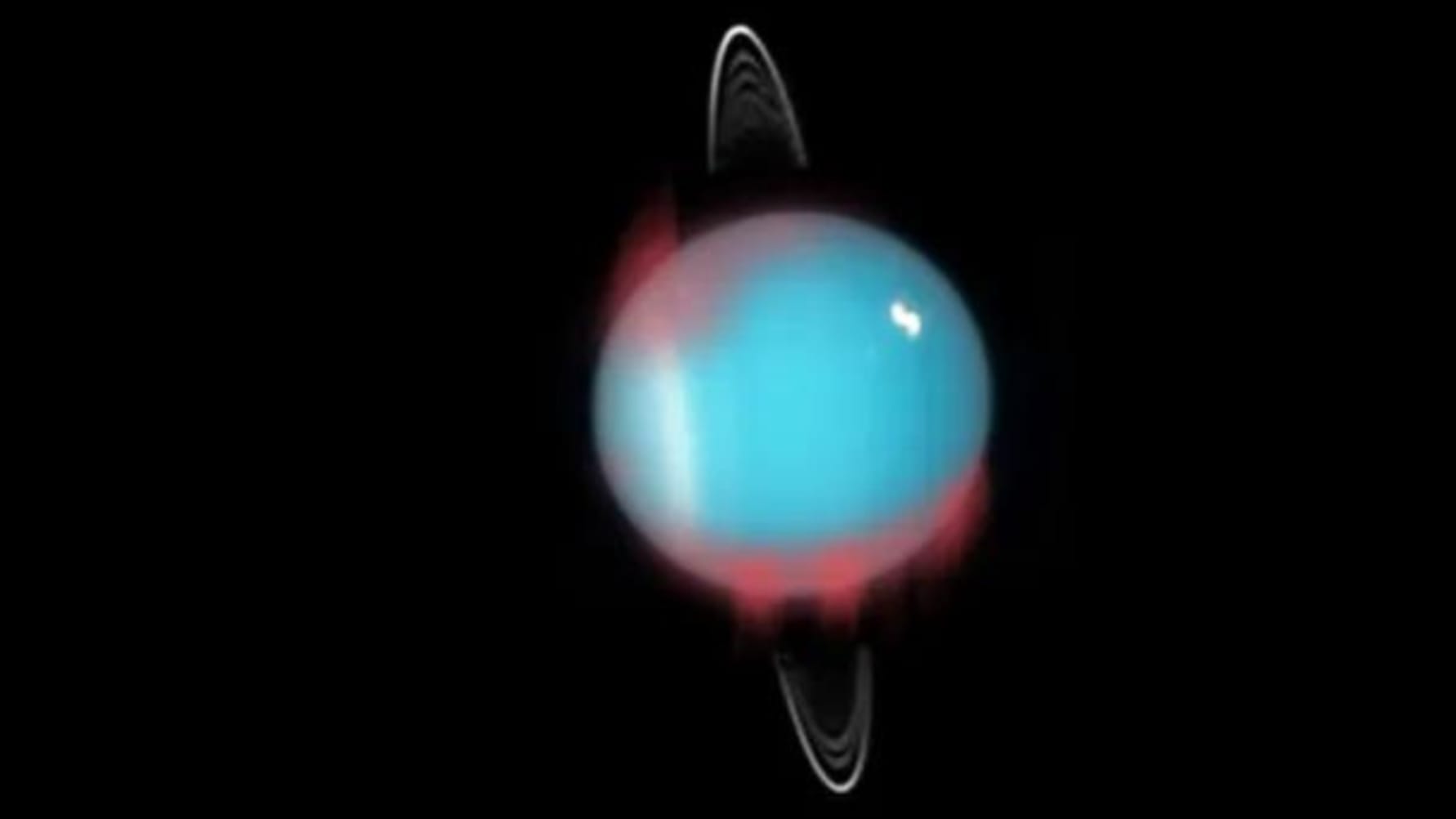After more than 30 years scientists have finally been able to confirm that the icy planet Uranus has an infrared aurora.
The discovery will provide insight into how magnetic fields on ice giants such as Uranus and Neptune behave and could even help astronomers use NASA’s James Webb Space Telescope to identify similar aurorae from planets outside our solar system.
The findings were made by Emma Thomas, a PhD student from the University of Leicester, under the supervision of planetary astronomer Professor Tom Stallard, of Northumbria University, with support from a team of scientists from both universities and funding from the Science and Technology Facilities Council (STFC).
The ice giants Uranus and Neptune are unusual planets in our solar system as their magnetic fields are misaligned with the axes in which they spin. While scientists have yet to find an explanation for this, clues may lie in Uranus’s aurora.
Aurorae are caused by highly energetic charged particles, which are funnelled down and collide with a planet’s atmosphere via the planet’s magnetic field lines. On Earth, the most famous result of this process are the spectacles of the Northern and Southern Lights. On planets such as Uranus, where the atmosphere is predominately a mix of hydrogen and helium, this aurora will emit light outside of the visible spectrum and in wavelengths such as the infrared.
While the ultraviolet aurorae of Uranus has been observed since 1986, no confirmation of the infrared aurora had been observed until now.
Using data gathered in 2006 using the Keck II telescope, the researchers studied infrared auroral measurements taken by analysing specific wavelengths of light emitted from Uranus. This method allowed them to analyse the light, known as emission lines, from the planet, similar to a barcode. In the infrared spectrum, the lines emitted by a charged particle known as H3+ will vary in brightness depending on how hot or cold the particle is and how dense this layer of the atmosphere is, meaning the lines act like a thermometer into the planet.
Their observations revealed distinct increases in H3+ density in Uranus’s atmosphere with little change in temperature, consistent with ionisation caused by the presence of an infrared aurora. Not only does this discovery provide better understanding of the magnetic fields of the outer planets of our own solar system, but it may also help in identifying other planets that are suitable of supporting life.
Speaking about the discovery, Professor Stallard said: “Attempting to measure the aurora at Uranus has given us more than three decades of challenge. When we took these observations of Uranus in 2006, we hoped there might be something important captured within them. Emma’s careful analysis has finally draw out the faint auroral signals from a planet more than four times further away than Jupiter.”
This year Professor Stallard was given rare access to NASA’s James Webb Space Telescope in order to observe the atmosphere of Jupiter, and believes the deep-space telescope could provide further insight into the aurora of other planets, as well as Uranus.
He added: “This detection is particularly timely – the James Webb Space Telescope could measure similar aurora in incredible detail, and with ongoing discussion about a future NASA mission to Uranus, an understanding of the aurora and the magnetic interactions that drive them to light up will greatly improve our plans for a future mission.”
The team’s findings have been published in the journal Nature Astronomy. Speaking about the research, lead author Emma Thomas, said: “The temperature of all the gas giant planets, including Uranus, are hundreds of degrees Kelvin/Celsius above what models predict if only warmed by the sun, leaving us with the big question of how these planets are so much hotter than expected? One theory suggests the energetic aurora is the cause of this, which generates and pushes heat from the aurora down towards the magnetic equator.
“A majority of exoplanets discovered so far fall in the sub-Neptune category, and hence are physically similar to Neptune and Uranus in size. This may also mean similar magnetic and atmospheric characteristics too. By analysing Uranus’s aurora which directly connects to both the planet’s magnetic field and atmosphere, we can make predictions about the atmospheres and magnetic fields of these worlds and hence their suitability for life.
“This paper is the culmination of 30 years of auroral study at Uranus, which has finally revealed the infrared aurora and begun a new age of aurora investigations at the planet. Our results will go on to broaden our knowledge of ice giant auroras and strengthen our understanding of planetary magnetic fields in our solar system, at exoplanets and even our own planet.”
It is thought the findings may also give scientists an insight into a rare phenomenon on Earth, in which the north and south pole switch hemisphere locations, known as geomagnetic reversal.
Emma adds: “We don’t have many studies on this phenomenon and hence do not know what effects this will have on systems that rely on Earth’s magnetic field such as satellites, communications and navigation. However, this process occurs every day at Uranus due to the unique misalignment of the rotational and magnetic axes. Continued study of Uranus’s aurora will provide data on what we can expect when Earth exhibits a future pole reversal and what that will mean for its magnetic field.”
Images and video available to download, see Notes to Editors for captions/credits: https://we.tl/t-aSmrafpvsZ
‘Detection of the infrared aurora at Uranus with Keck-NIRSPEC’ is published in Nature Astronomy, DOI: 10.1038/s41550-023-02096-5, Link: https://doi.org/10.1038/s41550-023-02096-5
